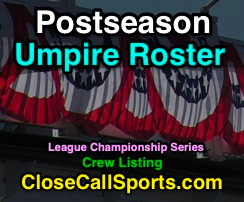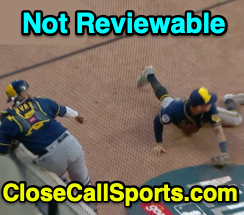Join us for discussion of the 2021 American and National League Division Series: As we have done in the past, we will post UEFL f/x plate scores for every home plate umpire this postseason.
Performance plate scores are listed following the completion of each contest according to UEFL f/x (StatCast data and application of
UEFL Rules 6-2-b-a [horizontal bound, "Kulpa Rule"] and
6-2-b-b [vertical strike zone, "Miller Rule"]) for called strikes and balls. Foul balls, swinging strikes, balls put in play, automatic balls, pitchouts, and hit-by-pitches are excluded from the analysis.
Click here to learn how UEFL f/x 3.0 plate scores work.
- 10/7 CWS@HOU Gm 1: Adam Hamari. 112/114 Balls + 42/51 Strikes = 154/165 = 93.3%. +1 HOU.
- 10/7 BOS@TB Gm 1: Dan Bellino. 90/95 Balls + 44/45 Strikes = 134/140 = 95.7%. +2 TB.
- 10/8 CWS@HOU Gm 2: Chris Conroy. 100/101 Balls + 43/44 Strikes = 143/145 = 98.6%. +0 Neutral.
- 10/8 ATL@MIL Gm 1: Mike Estabrook. 87/90 Balls + 32/35 Strikes = 119/125 = 95.2%. +2 MIL.
- 10/8 BOS@TB Gm 2: DJ Reyburn. 108/108 Balls + 46/49 Strikes = 154/157 = 98.1%. +3 BOS.
- 10/8 LAD@SF Gm 1: Carlos Torres. 69/70 Balls + 37/41 Strikes = 106/111 = 95.5%. +5 SF.
- 10/9 ATL@MIL Gm 2: Mike Muchlinski. 92/93 Balls + 49/53 Strikes = 141/146 = 96.6%. +1 MIL.
- 10/9 LAD@SF Gm 2: Angel Hernandez. 87/88 Balls + 41/46 Strikes = 128/134 = 95.5%. +0 Neutral.
- 10/10 TB@BOS Gm 3: Sam Holbrook. 116/120 Balls + 49/54 Strikes = 165/174 = 94.8%. +1 BOS.
- 10/10 HOU@CWS Gm 3: Tom Hallion. 134/139 Balls + 42/51 Strikes = 176/190 = 92.6%. +4 CWS.
- 10/11 MIL@ATL Gm 3: Alfonso Marquez. 90/91 Balls + 37/40 Strikes = 127/131 = 96.9%. +4 MIL.
- 10/11 TB@BOS Gm 4: Ron Kulpa. 73/75 Balls + 31/35 Strikes = 104/110 = 94.5%. +2 BOS.
- 10/11 SF@LAD Gm 3: Ted Barrett. 84/85 Balls + 39/46 Strikes = 123/131 = 93.9%. +4 LAD.
- 10/12 CWS@HOU Gm 4: Vic Carapazza. 117/120 Balls + 57/59 Strikes = 174/179 = 97.2%. +1 CWS.
- 10/12 MIL@ATL Gm 4: Tony Randazzo. 94/98 Balls + 46/50 Strikes = 140/148 = 94.6%. +2 ATL.
- 10/12 SF@LAD Gm 4: Pat Hoberg. 101/103 Balls + 41/42 Strikes = 142/145 = 97.9%. +1 LAD.
- 10/14 LAD@SF Gm 5: Doug Eddings. 86/87 Balls + 43/45 Strikes = 129/132 = 97.7%. +1 LAD.
The highest overall plate score during the 2020 Postseason was Hoberg/Hudson/Miller's 98.7% (WC/WS).

















